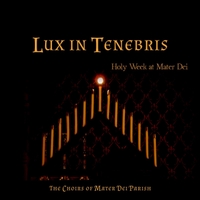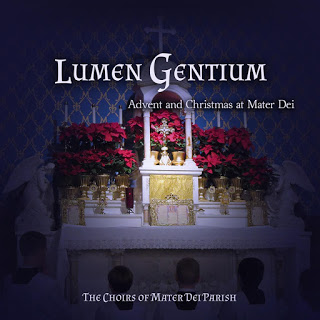We are now in Holy Week, the final days leading up to the Institution of the Sacred Priesthood and the Holy Eucharist, and the Passion and Death of Christ. The liturgies of the Church during this week are beautiful and profound. Our parish will have a completely Solemn Triduum this year – Solemn High liturgies on Holy Thursday, Good Friday, Easter Vigil, and Easter Morning, as well as two evenings of Tenebrae (Holy Thursday and Holy Saturday’s Tenebrae, both of which will be sung the evenings prior).
Tenebrae, meaning darkness, is basically matins and lauds combined and sung. After each of the psalms one of the candles on the Tenebrae hearse is extinguished. The six altar candles are extinguished during the Benedictus, and any remaining lights in the church are also put out. The last candle, representing Christ, is hidden behind the altar, signifying Christ’s death upon the Cross – this leaves the church in total darkness. The strepitus (“great noise”) is then made by slamming books shut, banging a book or a hand against a pew, or stomping on the floor. This “great noise” symbolizes the chaos in a world without Christ. After the “great noise” the candle representing Christ is brought back out from behind the altar and is placed at the top position of the hearse, and all rise and leave the church in silence.
This Holy Week our choirs will be singing a plethora of sacred music gems. Most of these pieces you can hear on our choir’s CD, but this Triduum we have some new pieces as well. Pieces repeated from last year include Ubi Caritas by Maurice Durufle, Popule Meus by Tomas Luis de Victoria, Miserere Mei by Gregoria Allegri, and O Jesu Christe by Jacquet de Mantua. New pieces for this year include the complete polyphonic responsories for the Holy Saturday Tenebrae Liturgy (which will be sung the previous evening, on Good Friday), the Kyrie and Gloria of the Missa Dies Sanctificatus by Palestrina, and Tenebrae Factae Sunt by Tomas Luis de Victoria.
This Holy Week, let us prepare our hearts and souls to share in Christ’s sufferings, as he is made obedient for us unto death, even to death on the cross.
You know that after two days shall be the pasch, and the son of man shall be delivered up to be crucified: Then were gathered together the chief priests and ancients of the people into the court of the high priest, who was called Caiphas: And they consulted together, that by subtilty they might apprehend Jesus, and put him to death. But they said: Not on the festival day, lest perhaps there should be a tumult among the people.




